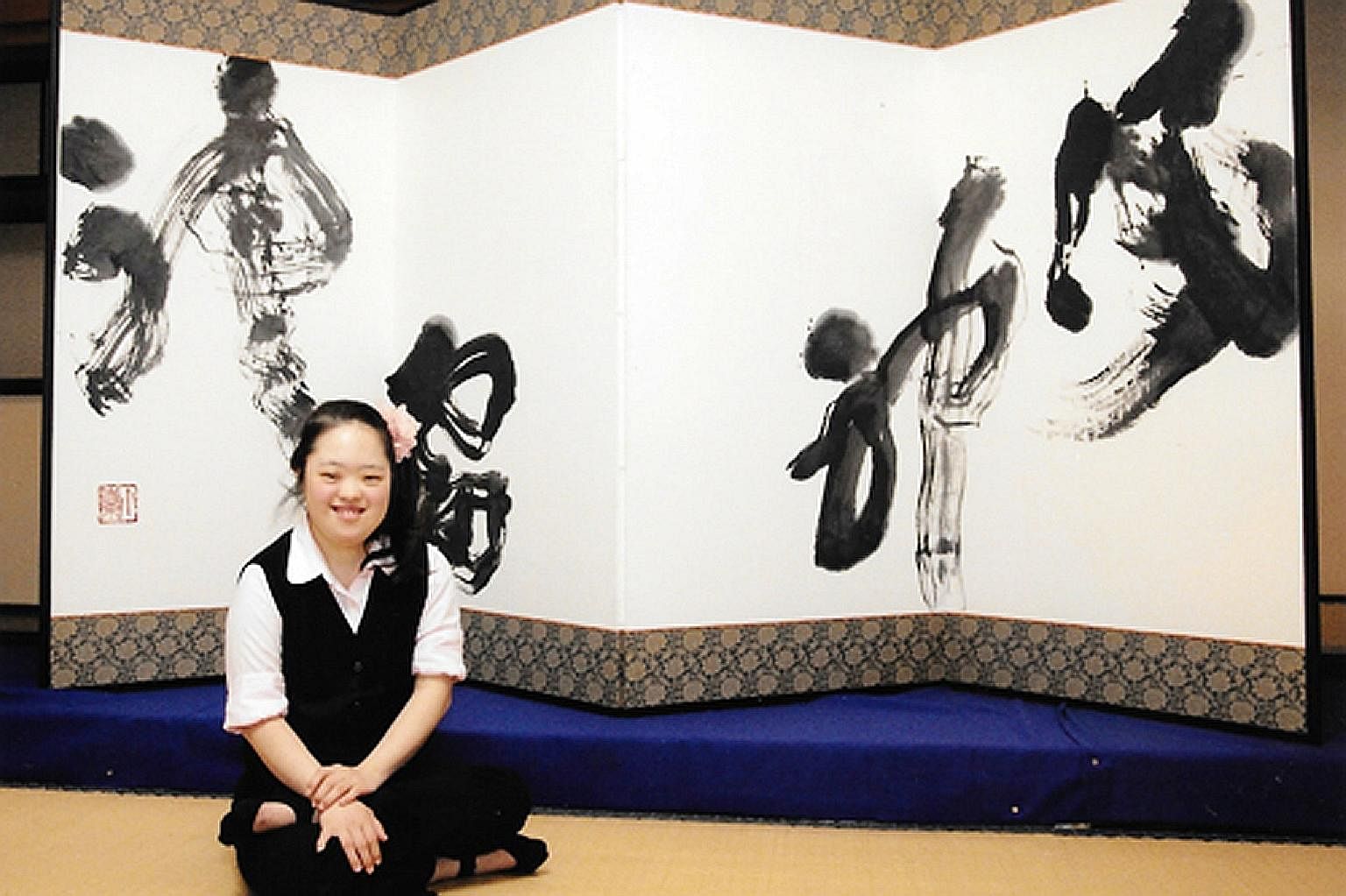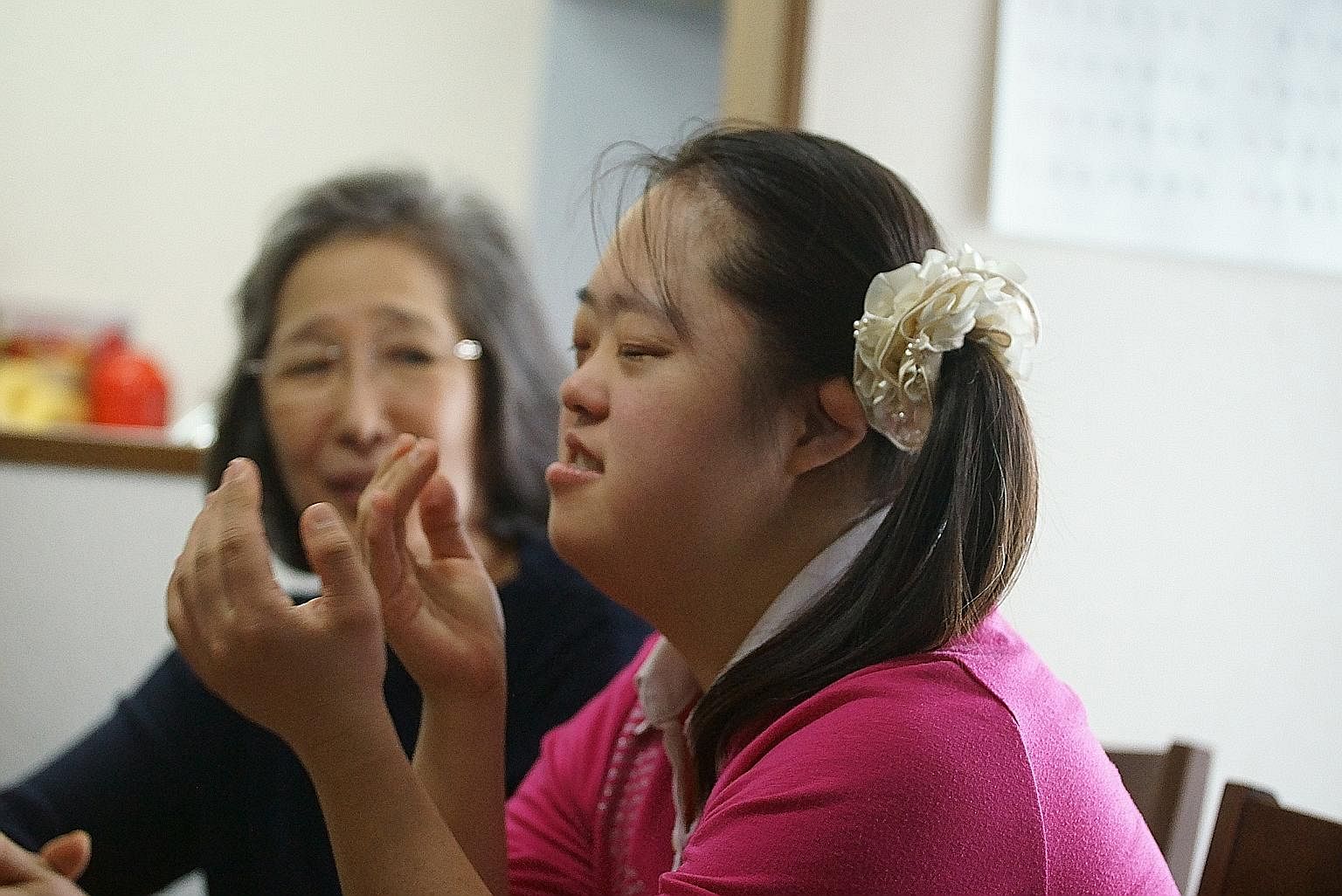It Changed My Life
It Changed My Life: Calligrapher Shoko Kanazawa moves people to tears with her art
Calligrapher Shoko Kanazawa has Down syndrome and does not always understand what she writes - but moves people to tears

A 400-year-old national treasure hangs in the main hall of the Kenninji Temple, the oldest Zen temple in Kyoto.
Called The Wind And Thunder Gods, this painting by Sotatsu Tawaraya depicts two celestial beings, one carrying a large bag of winds and the other beating a drum to create thunder.
Also hanging in the temple is a 2006 calligraphic rendition of this masterpiece, with the Chinese characters for Thunder God and Wind God viscerally etched in black ink against a giant white background.
This piece is intriguing for a couple of reasons. There is a lyrical symmetry to the two compositions, which is fascinating because the calligrapher Shoko Kanazawa had never seen Tawaraya's piece before putting ink to paper.
And Ms Kanazawa is no ordinary calligrapher. She has Down syndrome and does not always understand what she writes.
That, however, has not stopped her from being one of the most acclaimed artists in Japan. Her works, which hang in temples and museums throughout the country, have been known to make people weep.
She has wielded her ink brush in front of thousands, and held exhibitions in cities worldwide including New York and Paris.
In person, the 31-year-old is like a polite yet playful nine-year-old, radiating geniality and good cheer.
Dressed in a fuschia polo shirt, with her long hair swept into a side ponytail and held together with a white scrunchie, she is eager to practise the English phrases she has committed to memory.

"How do you do? My name is Shoko," she says in the family home in Kugahara, a quiet suburb about 40 minutes by train from Central Tokyo.
She is an only child.
Her parents fell in love after meeting at a Noh class. Noh is a traditional form of Japanese musical theatre.
Her late father ran a group of companies; her mother is a calligraphy teacher.

Talking through an interpreter, Mrs Yasuko Kanazawa, 73, says: "I was married for six or seven years before Shoko came along. I had a couple of miscarriages before that."
She was devastated when told that her baby had Down Syndrome, a genetic disorder that causes intellectual and developmental delays.
"I blamed myself because I got pregnant at a risky age. I was told that Shoko would not have intelligence and would not be able to work," says the soft-spoken woman. "I wanted to kill myself."
Her husband, however, was a pillar of strength. "Hiroshi was a very good man. He told me that we had to be proud of her because her illness - which affects one in 1,000 people - makes her special."
It took Mrs Kanazawa a long time to get over her guilt and sadness. Shoko, she says, played a big part in helping her.
"She was smart, clever and very loving. She made me realise that God doesn't create anything which is not necessary," she says.
When Shoko was five, Mrs Kanazawa managed to enrol her in a mainstream kindergarten.
"I told the teacher about her condition and that she needed special attention but the teacher said it was okay. She told me that Shoko really brightened up the classroom.
"Of course, she came in at the bottom for everything but she wasn't affected because she didn't understand competitiveness, or that she was last. She was very pleased with her friends and was a real mood maker."
Around this time, Mrs Kanazawa decided to start a calligraphy class for Shoko and a few of her classmates. "Shoko was the only one who could hold the brush in the correct manner. I thought she had potential."
When Shoko turned 10, she had to leave her mainstream elementary school to attend one for children with special needs. The school was not near their home, and Mrs Kanazawa was worried her daughter would have problems coping with a new environment.
"But going to that school was good for her. She was happy, she learnt how to take the train and how to take a short walk to the school. It made me realise she had never struggled with anything. I was the one struggling, I was the one thinking negatively."
To cope with her own distress, Mrs Kanazawa started teaching Shoko how to write the 272 kanji (Chinese characters used in written Japanese) in The Heart Sutra, a famous sutra in Mahayana Buddhism. "I was quite harsh and often got angry when Shoko didn't get it right. I was taking out my frustrations on her. But each time she completed a verse, she would say to me, 'Thank you, Mum'."
Shoko completed 10 sets of the sutra.
Mrs Kanazawa says: "She never once said she would quit although she did cry a lot. And when her tears fell, they would fall on the sheets of rice paper. That's why I now call that sutra the Tears Heart Sutra."
The environment Shoko grew up in, she says, played a big role in shaping her as a calligrapher.
"She has been observing me from the time she was in the cradle. She knew my grief. She just wanted me to be happy and that's the main motivation for her. That's how and why she developed her skills."
In 1999, Shoko's father, who was then 52, collapsed from a heart attack in front of her in their home.
Instinctively, his wife knew that it was fatal. She called out to her then 14-year-old daughter and told her: "Your father's spirit has entered your soul."
At this point, Shoko, who has been listening quietly during the interview, jumps in.
"My mother says my father is inside me. I understand that," says the artist, who prays to her father before every public performance.
When Shoko was 18, Mrs Kanazawa remembered something her late husband told her. "He appreciated Shoko's calligraphy more than I did and said she should have her own exhibition. He said we shouldn't hide Shoko's condition, we should use the exhibition to tell people how well Shoko was doing."
It set her thinking.
"We were alone. I was not young. Nobody was there to prove she really had talent. I started thinking about her future; I didn't want her to end up in a home."
The exhibition took two years to plan - and it changed their lives.
Mrs Kanazawa taught Shoko how to write big characters.
"I thought it was going to be a one-time event so I wanted to make it really big and special," she says, adding that it was held at the Ginza Shoro Gallery in Tokyo.
The event attracted a lot of press.
"A lot of people came and some people cried when they saw her works. It was magic; I'd never seen people crying over calligraphy," says Mrs Kanazawa, adding that several of the pieces were sold.
"It was never our idea to sell but when people asked to buy them, it struck me that Shoko's works were valuable and she might even be able to make a living."
And just like that, Shoko vaulted into the limelight. Her energetic and visceral brush strokes attracted the attention of representatives from galleries and museums, and even abbots of famous temples.
She started getting commissions calligraphers could only dream of, including for the title calligraphy for a period TV drama Taira no Kiyomori on NHK - the country's biggest broadcaster - in 2012.
In the last decade, she has performed at about 250 events held all over Japan, including famous temples such as the Todaiji in Nara and Kenchoji in Kamakura, attracting big crowds.
Two years ago, she was asked to write on 5x5 m sheets at the Japan National Gymnastics Meet at Ajinomoto Stadium, in front of Emperor Akihito and a crowd of more than 50,000.
There were no places spacious enough for her to practise writing such a big piece so her mother rented a temple. Shoko practised on the grounds just once.
"People were saying it was not possible but I believed in her because each time she faced a difficult situation, she would triumph. And she did it, her brush was 20kg. You can try holding it, it's there," she says, pointing to a giant brush in the living room.
Her performance was projected onto a giant screen in the stadium.
"I looked up at the screen, she was like a small bird in a big field. It was amazing," says Mrs Kanazawa.
Asked if she felt nervous performing before such a big crowd, Shoko says: "I always try to incorporate my happiness and encouragement into my writing. I don't feel any nervousness. My father is always observing me from heaven."
Not long after, mother and daughter received a poem written by Emperor Akihito commemorating the event. Shoko transcribed the poem, and it is now a monument at a park in Chofu, a suburb in Tokyo.
Last year, the young calligrapher made it to the United Nations on World Down Syndrome Day where she thanked her mother in a speech. At one stage, she looked at Mrs Kanazawa, who was sitting in the audience, and said: "My mother was once the saddest mother but now she's the happiest mother."
Indeed, Shoko has blossomed in ways which have surpassed Mrs Kanazawa's expectations.
Last year, she moved into a small apartment not far from the family home. "I love living on my own and I want to buy a book on being a YouTuber. I like to cook and I can make curry, steak, Chinese food, miso soup and fried rice," she says, rattling off the dishes in her culinary repertoire.
With a smile, her mother says: "I was desperate for her to become independent. Whatever calligraphy she does, how much money she earns doesn't help me. She has to live on her own after I'm gone. Her independence is my greatest accomplishment."
Proudly, she says a policeman told her how Shoko has already brightened her neighbourhood and won many people over.
"Shoko doesn't know if a person is rich or smart. She has no concept of wealth or authority. But she can tell if someone's sad or struggling with something and she always talks to people."
The Kanazawas will be in Singapore later this month.
Shoko will be drawing two pieces on Oct 23 at a charity gala organised by The Ad Planet Group to celebrate 50 years of bilateral and business relations between Singapore and Japan. Two of her framed pieces will be presented to Minister for Foreign Affairs Vivian Balakrishnan and Japanese Ambassador to Singapore Kenji Shinoda.
Between Oct 21 and 23, the public can catch this special calligrapher in action at Paragon mall.
Shoko is excited about her trip here, saying: "I want the people to look at my calligraphy. I want to inspire them with my calligraphy."
• Details of the trip can be found at www.sj50astrokeofgenius.sg.
VIDEO: Shoko Kanazawa draws strength from her late father http:// str.sg/4N2F
Join ST's Telegram channel and get the latest breaking news delivered to you.
A version of this article appeared in the print edition of The Sunday Times on October 02, 2016, with the headline It Changed My Life: Calligrapher Shoko Kanazawa moves people to tears with her art. Subscribe

